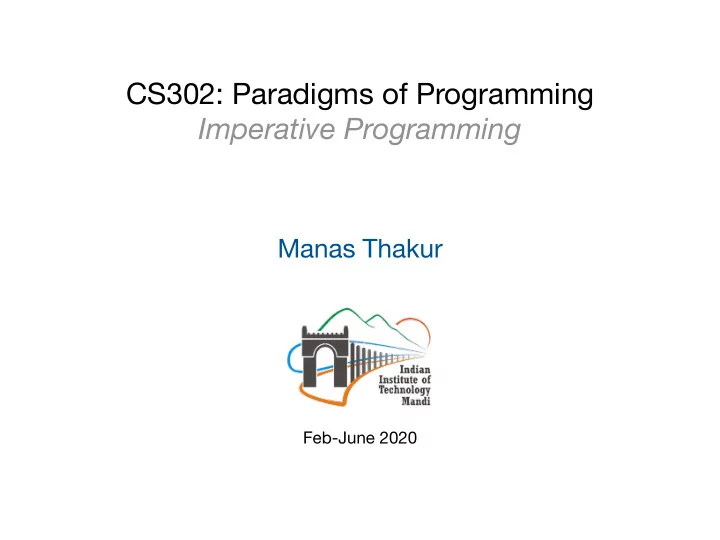

CS302: Paradigms of Programming Imperative Programming Manas Thakur Feb-June 2020
Credits • Some images have been taken from the “texinfo” format of “Structure and Interpretation of Computer Programs”, Second Edition, Universities Press, 2005; authors: Harold Abelson, Gerald Jay Sussman and Julie Sussman. 2
An objective world… • The world consists of independent objects , whose behaviour changes over time. • The changing behaviour can be captured using a snapshot of the state of individual objects. • The objects interact with each other and influence each other’s states. • In programming terms, the state of an object is modelled using local state variables . • We next need to see how could we model such time varying states . 3
A bank account • Classwork: • Write a function to ‘withdraw’ a given amount if an account has enough balance. • Another function should simulate the following over an account: • Initial balance: 100 • Amounts to withdraw: 20, 90, 30 4
Attempt 1 • Output: “Insu ffi cient balance” 5
Attempt 2 Problem: We need to maintain the balance of each account explicitly • Output: 50 while writing our operations. • What if we had two accounts? 1000 accounts? 6
What we want • An account that maintains its balance by itself. • Users need not have to “remember” the balance of each account and supply it to the withdraw procedure. • What does it need: • A way to remember the balance based on the history of transactions • Which needs a way to update the balance after each transaction • Which needs mutation ! 7
Mutations, assignments, states Called “set bang” • Scheme provides a special form set! to update the value of a variable: • set! <name> <new-value> • Traditionally, this is called an assignment • Mutations enabled by assignments lead to the notion of a state after each assignment 8
Imperative programming • An assignment updates the state. • A sequence of assignments leads to a sequence of states. • Hence, assignments are state ments (against expressions ). • Each assignment is like a command to change the state. • (Apple Dictionary) Imperative. giving an authoritative command • The practice of giving a sequence of commands to update states, in the form of assignment statements, defines the paradigm of imperative programming . 9
Account withdrawals in an imperative world • Notice the begin keyword for sequencing multiple statements • Co ff ee question: • Can you recall a place where we have used ‘begin’ implicitly? • Answer: What about multiple defines in a procedure? 10
Writing “withdrawal processors” (define W1 (make-withdraw 100)) (define W2 (make-withdraw 100)) > (W1 50) > 50 Multiple accounts without any hassle! > (W2 70) > 30 > (W2 40) > “Insufficient funds” > (W1 40) > 10 11
But an account can also get money in! A pakka object-oriented account :-) 12
Pros of Assignments • Ability to model the real world in terms of objects with local state • Proper modularity: independence of objects and users • Simpler bank account code! 13
Cons of Assignments • Our nice, simple substitution model of procedure application goes away for a toss! • Consider the following two procedures: Imperative Functional 14
Cons 1: Good-bye substitution model ((make-decrementer 25) 20) ==> ((lambda (amount) (- 25 amount)) 20) ==> (- 25 20) ==> 5 ((make-simplified-withdraw 25) 20) ==> ((lambda (amount) (set! balance (- 25 amount) 25) 20) ==> (set! balance (- 25 20)) 25 ==> Set balance to 5 and return 25 Consequence: “equals” cannot be substituted for “equals”. 15
Cons 2a: Bye-bye referential transparency Are D1 and D2 the same? > Arguably yes, because each could be substituted for the other. (define D1 (make-decrementer 25)) (define D2 (make-decrementer 25)) Are W1 and W2 the same? > They look to be, but aren’t: (W1 20) 5 (W1 20) (define W1 (make-withdraw 25)) -15 (define W2 (make-withdraw 25)) (W2 20) 5 Consequence: Can’t reason about correctness by “looking” at the program. 16
Cons 2b: Identity crisis • Two bank accounts are di ff erent even if they have the same balance. • A bank account remains to be the same even if its constituent data items or fields (i.e., the balance) changes. • A rational number 2/3 is not the same if its constituent data items (either the numerator or the denominator) change. • What’s the identity of a bank account then? Consequence: Extra e ff orts required for implementing ‘equals’ methods! 17
Cons 3: Inducing order into life • Consider this ‘imperative’ factorial program: • What if we wrote or performed the assignments in opposite order: Consequence: Di ffi cult parallelization. 18
Homework • Modify our account object to work with passwords: • Store password when creating an account • Authenticate before withdrawing money • How about no authentication for depositing money? ;-) • Tomorrow: • A substitution for substitution! 19
Recommend
More recommend